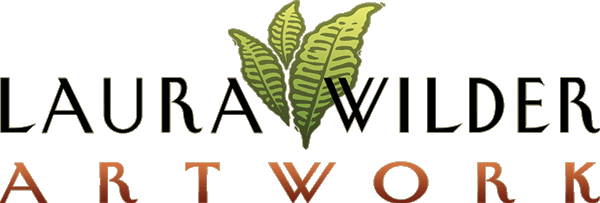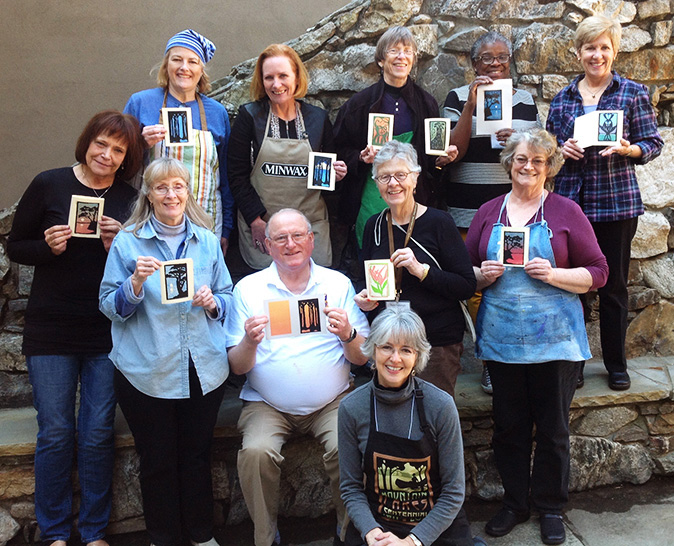Here are a few of the most frequently asked questions we encounter. Of course, if you have any unanswered questions, please get in touch!
1. What’s a block print?
It’s a print made by doing a separate hand-carving and printing for each color in the design. The carving can be done in wood or linoleum (I prefer the latter).
You do a carving, roll ink on its surface, and press paper against the inked carving, to make a print. The pressing can be done by rubbing it with a wooden spoon, or running it through a press. Repeat on more sheets of paper, plus many extras because you are going to screw up a bunch.
Now do the next carving, mix up ink color number two, roll it on the carving, and print it, perfectly aligned you hope, on top of the first color. Toss the ones you screw up. Keep impressionable children out of earshot. Repeat for the additional prints.
Keep going like this, carving and layering colors on top of each other, recognizing that mistakes are inevitable because this is very complicated and difficult.
When your edition of prints is finished, count and number the good ones. When you notice imperfections even in your best prints, repeat this mantra: “That is the charm of the handmade print.” Have a drink.
Read about my adventures in block printing on my blog page
2. What’s a giclee print, and how do you pronounce it?
It’s an archival quality reproduction of an original piece of fine art (or a photograph). In layman’s terms, it’s a very high end inkjet print. As far as I know, it’s the best quality reproduction you can get, having no dot pattern (as you would see in a magazine or mass-produced piece). Giclee printing is a slow process and meant for very small runs. It’s a French word that means “squirt,” and is pronounced gee-CLAY.
Giclee prints allow me to give some of my favorite sold-out block prints and paintings a new life as a smaller, more affordable piece of art.
My giclee print guy is brilliant, and graciously puts up with my fussiness to create beautiful, velvety reproductions of my art on paper that’s made from either 100% rag, or bamboo, a highly renewable resource.
3. I bought the matted print, but now I want it framed. Can you help?
Sure! Shoot me an email at laura@laurawilder.com and we’ll work it out. Usually folks send us the matted print, and we frame it for them. Or we can send you the frame (and UV-filtering glass), and if you have a point driver and hanging hardware, you can assemble it yourself. Or you can take the components to your local frame shop for assembly.
4. What is this mark? ![]()
It’s the Roycroft Renaissance mark, which I put with my signature on my block prints, and which appears on the frames that are handmade by Roycroft Renaissance Master Artisans.
5. What is the Roycroft Renaissance?
It’s a group of artisans to which I belong, who are inspired by the original Roycroft Artist’s Colony, during the Arts & Crafts Movement. Roycroft Renaissance Artisans have been certified by a very tough jury to put the “RR” mark on their work. That mark signifies a high level of artistry/craftsmanship, and that the piece was made with “head, heart, and hand.” That jury is made up of RR artisans who have been later elevated to Master Artisan level. I have been a Roycroft Renaissance Master Artisan in Printmaking for twenty years, and am honored to be a part of this amazing, talented group! For more information visit the Roycrofters At Large Association website.
6. Why do some prints have the RR mark on your signature, while others don’t?
I only put the mark on my handmade prints (block prints and serigraphs/screen prints).
7. Are low-numbered prints more desirable than high-numbered prints?
That may be true for prints made in such large editions that the carving, or plate, has started to wear down (and affect the image) near the end of the printing.
That is not true for my prints, since I never make editions large enough for the carving/block to start to wear out.
Also, the print you bought is only numbered based on where it was in the stack after the printing was finished. But each time I print another color on a stack of prints, the stack gets re-shuffled, as I lay them out to dry in piles, and then re-stack them for the next printing. It might have been the first print made with color number one, but the twenty-first print when I printed color number five.
8. What does it mean when, instead of being numbered, a print has “AP” written on it?
“AP” stands for “Artist’s Proof,” or a print that was identical to the numbered prints, but which the artist wanted to save for his/her own use. When I make a new edition of prints, I might have a hundred and twenty-six, but will write “1/120, 2/120, etc” on them, saving the last six to either keep, give to family, whatever. Sometimes, after all the numbered prints are sold, I will sell a few of the APs.
9. Where's your gallery/studio?
Online! The best place to see my art is on my website, at an art fest, or at an exhibition; otherwise, the actual art is usually stowed away in drawers, in boxes and on shelves at my house. I do my designing and carving at home, and my printing at the Flower City Arts Center, where members have access to lots of antique printing presses.
10. I live in your area. Can I pick up my order to save on the shipping cost?
We have so many requests to pick up artwork, and it is so time-consuming to coordinate schedules, that we prefer to simply pack and ship, or (with your permission) to leave the art in a protective bag, inside your storm door. But since you offered to pick up, as a courtesy, we will usually waive the shipping cost.
11. Do you take pet portrait commissions?
Years ago, I did! I love animals, and had fun doing many pet paintings, twenty-nine of which became a series of breed prints. But after doing at least forty pet portraits, I felt the need to move on!
12. Are you related to Laura Ingalls Wilder?
Yes! Laura’s husband Almanzo Wilder is my sixth cousin, three times removed, for what that’s worth. More importantly, I am a big fan, and have all of her books, and the new books about her life. I still re-read The Long Winter almost every year. It gives you a great sense of perspective and gratitude. When our furnace broke, and the house was 38 degrees for a couple days, it helped to think of how the Ingalls family survived so much worse, for many months, year after year. And complaining, even under those conditions, was shameful behavior. Those people were badasses!



